Role of NK cell subsets in organ-specific murine melanoma metastasis
- PMID: 23776508
- PMCID: PMC3679158
- DOI: 10.1371/journal.pone.0065599
Role of NK cell subsets in organ-specific murine melanoma metastasis
Abstract
Tumor metastasis plays a major role in the morbidity and mortality of cancer patients. Among solid tumors that undergo metastasis, there is often a predilection to metastasize to a particular organ with, for example, prostate cancer preferentially metastasizing to bones and colon cancer preferentially metastasizing to the liver. Although many factors are thought to be important in establishing permissiveness for metastasis, the reasons for organ-specific predilection of each tumor are not understood. Using a B16 murine melanoma model, we tested the hypothesis that organ-specific NK cell subsets play a critical role in organ-specific metastasis of this tumor. Melanoma cells, given intravenously, readily colonized the lungs but not the liver. NK cell depletion (either iatrogenically or by using genetically targeted mice) resulted in substantial hepatic metastasis. Analysis of NK cell subsets, defined by the differential expression of a combination of CD27 and CD11b, indicated a significant difference in the distribution of NK cell subsets in the lung and liver with the mature subset being dominant in the lung and the immature subset being dominant in the liver. Several experimental approaches, including adoptive transfer, clearly indicated that the immature hepatic NK cell subset, CD27+ CD11b-, was protective against liver metastasis; this subset mediated its protection by a perforin-dependent cytotoxic mechanism. In contrast, the more mature NK cell subsets were more efficient at reducing pulmonary tumor load. These data indicate that organ-specific immune responses may play a pivotal role in determining the permissiveness of a given organ for the establishment of a metastatic niche.
Conflict of interest statement
Figures

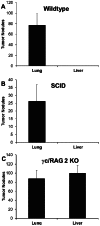
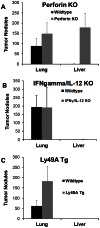
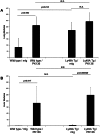

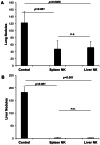
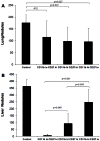


Similar articles
-
Innate and adoptive immune cells contribute to natural resistance to systemic metastasis of B16 melanoma.Cancer Biother Radiopharm. 2015 Mar;30(2):72-8. doi: 10.1089/cbr.2014.1736. Epub 2015 Feb 25. Cancer Biother Radiopharm. 2015. PMID: 25714591
-
IFN-γ production by lung NK cells is critical for the natural resistance to pulmonary metastasis of B16 melanoma in mice.J Leukoc Biol. 2011 Oct;90(4):777-85. doi: 10.1189/jlb.0411208. Epub 2011 Jun 28. J Leukoc Biol. 2011. PMID: 21712396
-
Role of organ-associated NK cells in decreased formation of experimental metastases in lung and liver.J Immunol. 1985 Jun;134(6):4267-75. J Immunol. 1985. PMID: 3989307
-
[Metastatic uveal melanoma. Development of neoadjuvant treatment in animal experiments].Ophthalmologe. 2001 Aug;98(8):761-5. doi: 10.1007/s003470170084. Ophthalmologe. 2001. PMID: 11552416 Review. German.
-
The nexus of natural killer cells and melanoma tumor microenvironment: crosstalk, chemotherapeutic potential, and innovative NK cell-based therapeutic strategies.Cancer Cell Int. 2023 Dec 6;23(1):312. doi: 10.1186/s12935-023-03134-y. Cancer Cell Int. 2023. PMID: 38057843 Free PMC article. Review.
Cited by
-
CD97 promotion of gastric carcinoma lymphatic metastasis is exosome dependent.Gastric Cancer. 2016 Jul;19(3):754-66. doi: 10.1007/s10120-015-0523-y. Epub 2015 Aug 2. Gastric Cancer. 2016. PMID: 26233326 Free PMC article.
-
Association of Germline Variants in Natural Killer Cells With Tumor Immune Microenvironment Subtypes, Tumor-Infiltrating Lymphocytes, Immunotherapy Response, Clinical Outcomes, and Cancer Risk.JAMA Netw Open. 2019 Sep 4;2(9):e199292. doi: 10.1001/jamanetworkopen.2019.9292. JAMA Netw Open. 2019. PMID: 31483464 Free PMC article.
-
Inflammation markers in cutaneous melanoma - edgy biomarkers for prognosis.Discoveries (Craiova). 2015 Mar 27;3(1):e38. doi: 10.15190/d.2015.30. Discoveries (Craiova). 2015. PMID: 32309563 Free PMC article. Review.
-
Lung cancer with gastrointestinal metastasis - review of theories of metastasis with three rare case descriptions.Cancer Microenviron. 2013 Dec;6(3):203-11. doi: 10.1007/s12307-013-0135-1. Epub 2013 Aug 21. Cancer Microenviron. 2013. PMID: 23963996 Free PMC article.
-
The effect of organ-specific tumor microenvironments on response patterns to immunotherapy.Front Immunol. 2022 Nov 17;13:1030147. doi: 10.3389/fimmu.2022.1030147. eCollection 2022. Front Immunol. 2022. PMID: 36466910 Free PMC article. Review.
References
-
- Coghlin C, Murray GI (2010) Current and emerging concepts in tumour metastasis. J Pathol 222: 1–15. - PubMed
-
- Guise T (2010) Examining the metastatic niche: targeting the microenvironment. Semin Oncol 37 Suppl 2S2–14. - PubMed
-
- Spano D, Zollo M (2012) Tumor microenvironment: a main actor in the metastasis process. Clin Exp Metastasis 29: 381–395. - PubMed
Publication types
MeSH terms
LinkOut - more resources
Full Text Sources
Other Literature Sources
Molecular Biology Databases
Research Materials

